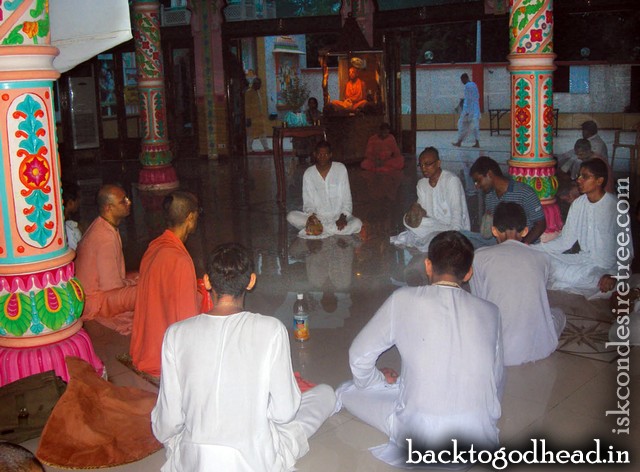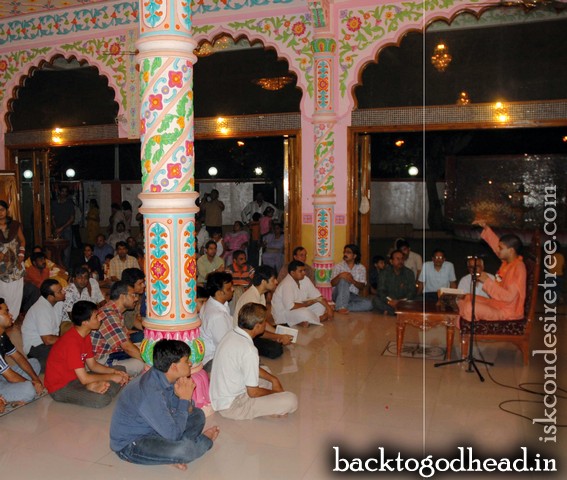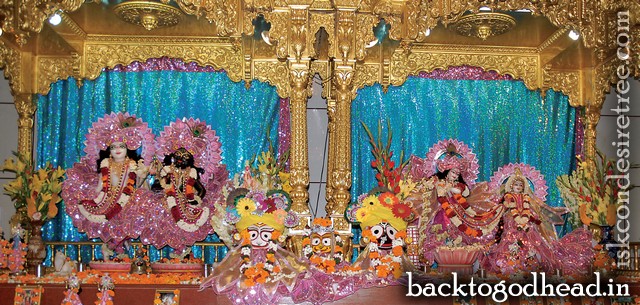Haribol! Hurry up! We’re getting late!” My husband was yelling at me at the top of his voice. We had an appointment to keep, but I was taking longer than usual. My hesitation and awkwardness were evident. We were going to meet a rich man to beg alms to help us in relocating our temple, and we’d never done anything like this before.

ISKCON Punjabi Bagh (Delhi) was in a crisis, and all of us a handful of resident and congregation devotees accepted the responsibility of steering out of it. Our beloved deities of Sri Sri Radhika-Ramana and Sri Sri Jagannatha, Baladeva, and Subhadra had been residing in the same building for eighteen years, but now the owner of the property had sent a legal notice asking Them to leave. Bewildered, we had to look for another place. We definitely wanted a bigger and better building because the congregation was growing, thanks to the temple’s commitment to outreach programs.
To look for a place befitting Their Lordships in this posh suburb was an immense task. But the Supreme Lord, Krishna, answered our sincere prayers, dispelling all fears. My husband, Rasapriya Dasa, a real estate agent, found a big building on a prime road. Without much hassle, city authorities approved the purchase. But where would the money come from? We needed huge amount in a very short time.
Inspired by our spiritual master, His Holiness Gopala Krishna Goswami, and committed to serving Srila Prabhupada’s mission, my husband and I undertook to collect an amount that seemed huge to us. All the devotees, irrespective of their varna or ashrama, put their heads and hearts together to secure the payment for the new temple.
How could the Lord not help us? We were determined to install the deities in the palace of our dreams. With sheer enthusiasm devotees raised money through the life membership program, book distribution, and donations. A “New Temple Project Team” was formed under the chairmanship of Vedavyasa Dasa, who encouraged all the members to forge ahead, while he accepted the responsibility of procuring a major share of the donations. Thus his managerial skills and Gopala Krishna Goswami’s blessings led to the achievement of our goal.
The Lord rewarded our sincere efforts, and we were successful in getting the new place registered in ISKCON ’s name within the stipulated time. ISKCON Punjabi Bagh’s growth from a tiny outpost to a huge temple is a living example of the devotees’ vigor and enthusiasm.
Prabhupada’s Desire

“I wish to construct a grand temple of Krishna-Balarama. . . The residents of New Delhi will be very much encouraged to visit. . . . That is my ambition.” (Srila Prabhupada, letter to Tejiyas Dasa, then temple president, New Delhi, 1975)
Gopala Krishna Maharaja often quoted these lines when he talked about installing Krishna-Balarama deities in a big temple in Delhi. As we were successful in acquiring a big place, he wanted us now to welcome the divine cowherd boys too. Under his guidance and blessings, the entire congregation and all the temple devotees worked hard in the fruition of this holy seed planted by Srila Prabhupada.
After thirty-two years Prabhupada’s divine desire bore fruit, bringing joy to the devotees’ hearts. The magnificent, enchanting cowherd boys Krishna-Balarama arrived at Punjabi Bagh (one of ISKCON ’s leading centers in India) on the auspicious occasion of Radhastami (September 20, 2007).
A four-day festival led up to the main installation ceremony. All around Delhi huge billboards with pictures of Krishna-Balarama advertised Their divine arrival. With deep faith and conviction, hundreds of devotees took part in the traditional yajnas and pujas, and eight thousand people witnessed the installation.
Temple Activities
The Sri Sri Radhika-Ramana Krishna-Balarama Temple and Vedic Education Centre is playing a vital role in propagating Vedic knowledge. Under the leadership of co-president (with Varaha Dasa) Rukmini Krishna Dasa, the ISKCON Youth Forum (IYF) is making news in North India with its audiovisual programs in schools, colleges, and universities. Young devotees are also the backbone of a vibrant book-distribution program, which in 2006 ranked third in all of ISKCON , with 2.25 million books sold.
The temple’s thirty-plus Bhakti-Vriksha and Nama Hatta programs are popular with congregation members in and around Punjabi Bagh. The temple also conducts a bimonthly program for the inmates of Delhi Prison.
We devotees at ISKCON Punjabi Bagh are happy that Prabhupada’s desire for Krishna-Balarama deities in Delhi has been fulfilled. And we pray that he may bless us to carry out more of his plans to spread Krishna consciousness in this important city.
The New Temple
The new Punjabi Bagh temple looks like a grand palace, showcasing the skills of craftsmen from neighboring states. For example, artisans from Rajasthan carved the beautiful jarokhas (traditional windows) and engraved flowers and leaves on the roof, walls, and pillars. Everything is painted exquisitely in vibrant colors, the matt finish giving the temple a bright but subtle look.
Russian artist Anjana Dasa brought inside walls to life with original paintings of Lord Venkatesvara, Sri Narsimhadeva, and Damodara-lila. The royal golden simhasana (throne) for Radhika-Ramana and Krishna-Balarama was built in Ahmedabad, a city renowned for handmade wooden artifacts. The grand crystal chandelier fills the 2,200-square-foot temple hall with yellow light, adding to the Their Lordship’s radiance. The beautiful modern tiled flooring, the state-of-the-art sound system, and the air conditioning make the temple the perfect place to absorb oneself in hearing, speaking, and singing about Krishna.
The majestic entrance resembles the gate of a fort, with dioramas of Krishna’s pastimes adorning its two sides. In the massive courtyard the royal eagle Garuda faces the deities with folded hands. Nestled in the corner of the courtyard is a lotus-shaped fountain, its beautiful mosaic work depicting colorful fishes that give pleasure to Their Lordships. Rama Dasa, from Kenya, dedicated his time to supervising this project.
Radhika Krpa Devi Dasi, a disciple of His Holiness Gopala Krishna Goswami, is a fashion designer who designs and sells Indian dresses. She also designs outfits for ISKCON deities and regularly travels and gives talks on Krishna consciousness

